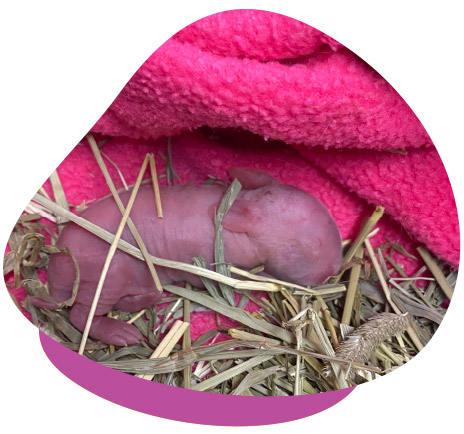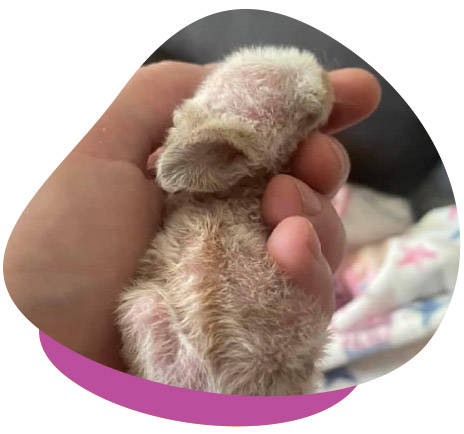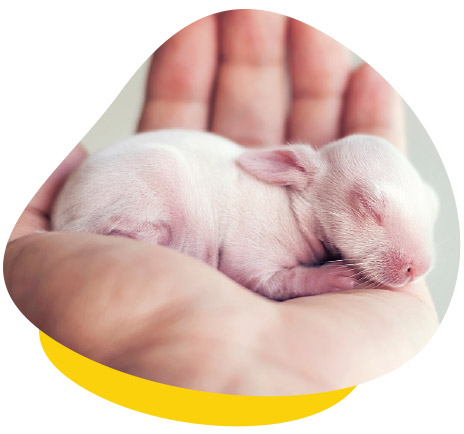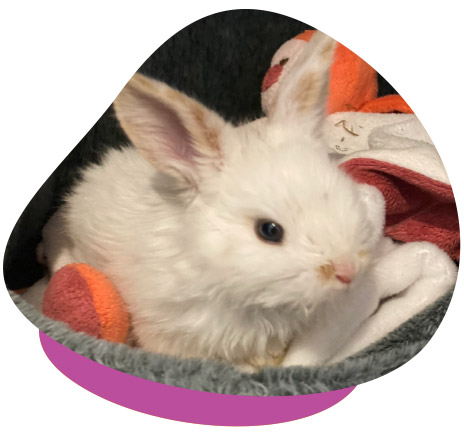Hand-raising baby rabbits can be tricky and demanding, requiring a lot of time and dedication. This responsibility should never be taken lightly, and some points should be considered before deciding to hand-raise a baby bunny.
First and foremost, it is important to be 100% sure that the mother rabbit isn’t feeding the babies. Unless the mother rabbit is known to be deceased, there is a good chance that she is feeding her babies, even if it appears that she might be ignoring them.
A mother rabbit does not constantly tend to her babies the way we might think. Instead, they generally feed their babies only once or twice per day and then leave them alone, which is normal and natural behaviour. In the wild, a mother rabbit generally stays as far away from the nest as possible to avoid attracting predators to her babies. She will only revisit the nest to feed her young.

Signs of Neglect
If you think the mother rabbit is “ignoring” her litter, have a look at the babies. If the babies’ tummies are round and full looking, they are warm, their skin is not wrinkled, and they are sleeping calmly in the nest, then the mother rabbit is likely feeding them. If the babies are wrinkled, cold or have shrunken bellies, then this is a sign you may have to intervene.
Handling Newborn Rabbits
Before handling the babies, you must wash your hands well. This removes bacteria and eliminates any smells from other objects or animals that can stress the babies. Once your hands are clean, rub your hands in a bit of clean, fresh hay and on the mother rabbit’s fur to scent your hands.

Feeding Newborn Rabbits
Before starting any syringe or bottle-feeding, it is worth trying to get the babies to feed off their mum. There are a couple of ways to do this.
-
- Hold the mother over the babies in the nest to give the babies enough time to feed.
- Another option is to hold the mother rabbit on her back in your arms and gently try to put each baby onto a nipple to self-feed. Sometimes it is helpful for the babies if a small amount of milk is expressed from the nipple to entice the baby to suckle.
If these two methods prove unsuccessful is not successful, then you may need to start hand-raising.

Providing Warmth
It is best to keep the babies in a warm, quiet place in a nest. Bunny fur is the best lining for the nest, but clean cotton wadding will do as a substitute. Just be sure the babies do not get tangled in it. For heating, two or more babies usually can snuggle and keep each other warm if they have a good nest. If there’s only one baby, a warm water bottle or heat pack wrapped in a soft towel can provide an excellent heat source however be sure the baby can crawl away if it feels too warm.
Formula and Feeding Supplies
We recommend using the Wombaroo Rabbit Milk as it is well balanced and contains a ‘milk oil’ equivalent which is important for baby rabbits. It comes as a powder that can be mixed with warm water to make milk for the babies. All the mixing instructions are on the box. Wombaroo Rabbit Milk can be purchased from The Unusual Pet Vets, some veterinary clinics and pet stores.
You will also need some small plastic syringes for feeding the milk to the babies. These are available from the Unusual Pet Vets, as well as some pharmacies.
You can also purchase small plastic feeding bottles and plastic teats from some large pet shops; however, you will need to buy the smallest teat possible as usually the puppy and kitten ones are too big. Most baby rabbits will feed from a syringe without a problem.
A small set of scales to weigh the baby rabbits will also be required. The amount of milk to feed is dependent on the baby rabbit’s weight. There is a weight chart on the Wombaroo Rabbit Milk box and the mls of milk to be fed over 24 hours. How much the baby rabbit will take in one feeding session depends on how frequently you have the feed them.

Feeding Procedure
When feeding, it is important to prevent aspiration (inhalation) of the formula by the babies. The smallest drop of formula in the lungs can cause fatal pneumonia within a few hours. The following instructions provide a step-by-step feeding guide:
Step 1
Make sure all your syringes and bottles have been washed before use.
Step 2
Baby rabbits can be wiggly and unpredictable, so ensure they are fed in a safe place where they cannot fall.
Step 3
Hold the baby upright (or in some cases on their back gently) in one hand and the bottle/syringe in the other.
Step 4
Babies often resist feeding at first, and you must overcome the temptation to force-feed. If the baby doesn’t accept the teat or syringe, then wet the baby’s lips with a drop of warm formula so they will hopefully lick it off. Once they have swallowed that, repeat the procedure over and over. Be persistent and gentle. In most cases, the baby will soon learn about feeding time and take the formula willingly though they may not do this on the first feeding.
Step 5
Do not be too forceful and squeeze too much formula into the baby rabbit’s mouth. They can aspirate milk quite easily, so only drip the formula slowly for the baby to lick up.
Step 6
If the baby grabs the teat and begins suckling, allow them to do so without adding any pressure yourself. The baby should be able to suckle with enough strength to empty the bottle or syringe without any help from you. If you provide extra force, the baby may accidentally aspirate formula that’s coming in too fast.
Step 7
If the baby does not suckle, it’s generally not a major problem. Most will learn to lap/sip from the tip of the teat, and this is safer in many cases as it does reduce the risk of aspiration. Try to hold the teat/syringe tip sideways or down-pointed (so the plunger is lower than the tip) relative to the mouth to further reduce the risk of aspiration.
Step 8
Until they open their eyes, handle the babies as little as possible when you’re not feeding.

Urination and Defecation
Many newborn mammals cannot urinate/defecate on their own. Many baby bunnies will require the stimulation of the mother’s grooming tongue on their bellies and genital region in order to release a stream of urine and faeces. If you are hand-raising, then you will need to try to mimic this behaviour. To do this, use a cotton ball moistened with warm water, and gently tap/rub the urogenital area until you feel the baby’s abdominal muscles tense and release a stream of urine or pass faeces. Getting this response may take 15-20 seconds of stimulation, or even more in some cases.
Baby rabbits’ eyes open at about 10 days of age. Once this occurs, you can gradually introduce them to timothy and oaten hay, pellets, small amounts of green vegetables, and water in a shallow dish.
By 2 – 4 weeks of age, normally, baby rabbits will start eating their mother’s caecotrophs to keep their gastrointestinal tract full of good bacteria. If you have access to the mother rabbit or another healthy rabbit’s caecotrophs – mix them with some formula or some warm water and syringe feed this to the babies. It is good to repeat this 2 or 3 times over a 2 – 3 week period to help them establish normal gastrointestinal flora.
Weaning
A mother rabbit feeds her babies for about 3 – 6 weeks, gradually decreasing the frequency of feedings until they lose interest. Your baby bunnies will start to nibble solid food at about the age of two to three weeks, but this does not mean they are ready to be weaned.
If the babies still beg for nursing by the age of 6-8 weeks, you can begin to dilute the formula with clean drinking water to help the weaning process. Start with 25% water to 75% formula, and gradually decrease the percentage of milk until the babies lose interest.
Baby rabbits can then be rehomed to new families by 8 weeks of age, as long as they are fully weaned and eating solids well on their own.


Vaccinations
Baby rabbits should then be vaccinated against Calici Virus when they are eight weeks old, then a booster is required four weeks later, and then bi-annually from then on.
Sterilisation
Rabbits can generally be sterilised from 4 months of age for males and 5 months for females. Male and female baby rabbits should be separated from each other by 10 – 12 weeks of age to prevent any early pregnancies.
If you have any further questions, please don’t hesitate to get in touch with us or book an appointment with a rabbit vet.

